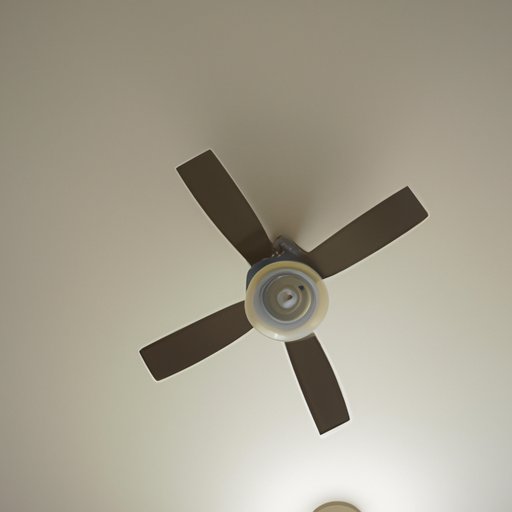Introduction
A ceiling fan is an essential appliance in many homes. It’s a great way to cool down during hot weather and can help reduce energy costs. But how does a ceiling fan work? In this article, we’ll explore the physics and mechanics of ceiling fans and provide some helpful tips for choosing and maintaining them.

Exploring The Physics Behind Ceiling Fans
Ceiling fans use a combination of physics and mechanics to generate airflow. The blades of the fan are shaped like airplane wings and are angled slightly downward. As the motor spins the blades, air is pushed downward and creates a cooling effect. This is known as the “wind chill effect”.
The shape and angle of the blades determine how much air is moved. Different types of blades produce different amounts of airflow. For example, curved blades create more airflow than straight blades. Additionally, the number of blades on the fan affects the amount of air moved. More blades will move more air than fewer blades.
Ceiling fans can also be used to create an updraft or downdraft. By adjusting the angle of the blades, you can push air upward or downward. This can be useful for circulating air in a room or redirecting airflow from a heat source such as a fireplace.

The Mechanics of Operating a Ceiling Fan
Most ceiling fans come with a pull chain that can be used to control the speed of the fan. Pulling the chain will turn the fan on and off and can also be used to adjust the speed. Some fans may also have a switch on the side of the motor that can be used to control the speed.
For ceiling fans that are wired into a wall switch, the switch must be in the correct position in order for the fan to work. Generally, the switch should be in the “on” position when the fan is turned on and in the “off” position when the fan is turned off. Some ceiling fans may also be controlled with a remote control.
Installing a remote control for your ceiling fan is relatively simple. The remote control usually comes with instructions and all necessary wiring. Once the wiring is connected, the fan can be operated with the remote control.
Benefits of Installing Ceiling Fans in Your Home
Ceiling fans offer several benefits to homeowners. They can help improve air circulation in a room, which can make it feel cooler. This can help reduce cooling costs in the summer months. Additionally, ceiling fans can help improve air quality by circulating dust and other airborne particles.
How to Choose the Right Ceiling Fan for Your Room
When choosing a ceiling fan for your home, there are several factors to consider. The size and shape of the room will determine the size and type of fan you need. You should also consider the location of the fan and the type of blades you want. Finally, if you want to add lighting, there are several options available.
An Overview of Ceiling Fan Technology
Ceiling fans typically use either direct current (DC) motors or alternating current (AC) motors. DC motors are more efficient and quieter than AC motors, but they tend to be more expensive. Smart ceiling fan technology is also becoming increasingly popular. Smart fans can be controlled through a smartphone app or voice commands.

Maintenance Tips for Keeping Your Ceiling Fan Working Properly
To keep your ceiling fan working properly, you should clean the blades regularly and check the wiring. You should also lubricate the bearings every few months. This will help ensure that the fan runs smoothly and efficiently.
Conclusion
Ceiling fans are an essential part of any home. They can help keep you cool and reduce energy costs. Understanding the physics and mechanics of how ceiling fans work can help you make informed decisions when choosing and maintaining a fan. With the right care and maintenance, your ceiling fan can last for years.


